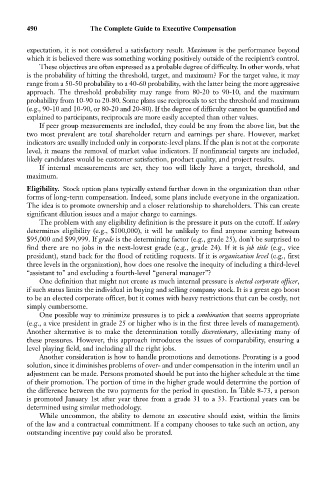Page 504 - Bruce Ellig - The Complete Guide to Executive Compensation (2007)
P. 504
490 The Complete Guide to Executive Compensation
expectation, it is not considered a satisfactory result. Maximum is the performance beyond
which it is believed there was something working positively outside of the recipient’s control.
These objectives are often expressed as a probable degree of difficulty. In other words, what
is the probability of hitting the threshold, target, and maximum? For the target value, it may
range from a 50-50 probability to a 40-60 probability, with the latter being the more aggressive
approach. The threshold probability may range from 80-20 to 90-10, and the maximum
probability from 10-90 to 20-80. Some plans use reciprocals to set the threshold and maximum
(e.g., 90-10 and 10-90, or 80-20 and 20-80). If the degree of difficulty cannot be quantified and
explained to participants, reciprocals are more easily accepted than other values.
If peer group measurements are included, they could be any from the above list, but the
two most prevalent are total shareholder return and earnings per share. However, market
indicators are usually included only in corporate-level plans. If the plan is not at the corporate
level, it means the removal of market value indicators. If nonfinancial targets are included,
likely candidates would be customer satisfaction, product quality, and project results.
If internal measurements are set, they too will likely have a target, threshold, and
maximum.
Eligibility. Stock option plans typically extend further down in the organization than other
forms of long-term compensation. Indeed, some plans include everyone in the organization.
The idea is to promote ownership and a closer relationship to shareholders. This can create
significant dilution issues and a major charge to earnings.
The problem with any eligibility definition is the pressure it puts on the cutoff. If salary
determines eligibility (e.g., $100,000), it will be unlikely to find anyone earning between
$95,000 and $99,999. If grade is the determining factor (e.g., grade 25), don’t be surprised to
find there are no jobs in the next-lowest grade (e.g., grade 24). If it is job title (e.g., vice
president), stand back for the flood of retitling requests. If it is organization level (e.g., first
three levels in the organization), how does one resolve the inequity of including a third-level
“assistant to” and excluding a fourth-level “general manager”?
One definition that might not create as much internal pressure is elected corporate officer,
if such status limits the individual in buying and selling company stock. It is a great ego boost
to be an elected corporate officer, but it comes with heavy restrictions that can be costly, not
simply cumbersome.
One possible way to minimize pressures is to pick a combination that seems appropriate
(e.g., a vice president in grade 25 or higher who is in the first three levels of management).
Another alternative is to make the determination totally discretionary, alleviating many of
these pressures. However, this approach introduces the issues of comparability, ensuring a
level playing field, and including all the right jobs.
Another consideration is how to handle promotions and demotions. Prorating is a good
solution, since it diminishes problems of over- and under compensation in the interim until an
adjustment can be made. Persons promoted should be put into the higher schedule at the time
of their promotion. The portion of time in the higher grade would determine the portion of
the difference between the two payments for the period in question. In Table 8-73, a person
is promoted January 1st after year three from a grade 31 to a 33. Fractional years can be
determined using similar methodology.
While uncommon, the ability to demote an executive should exist, within the limits
of the law and a contractual commitment. If a company chooses to take such an action, any
outstanding incentive pay could also be prorated.

